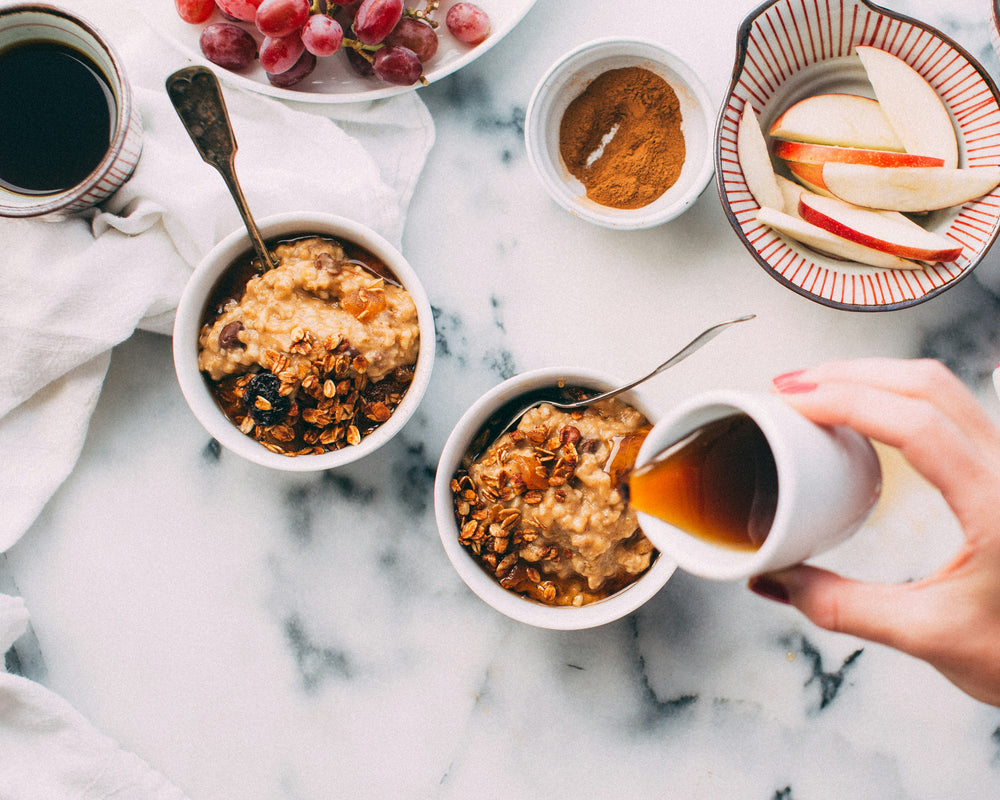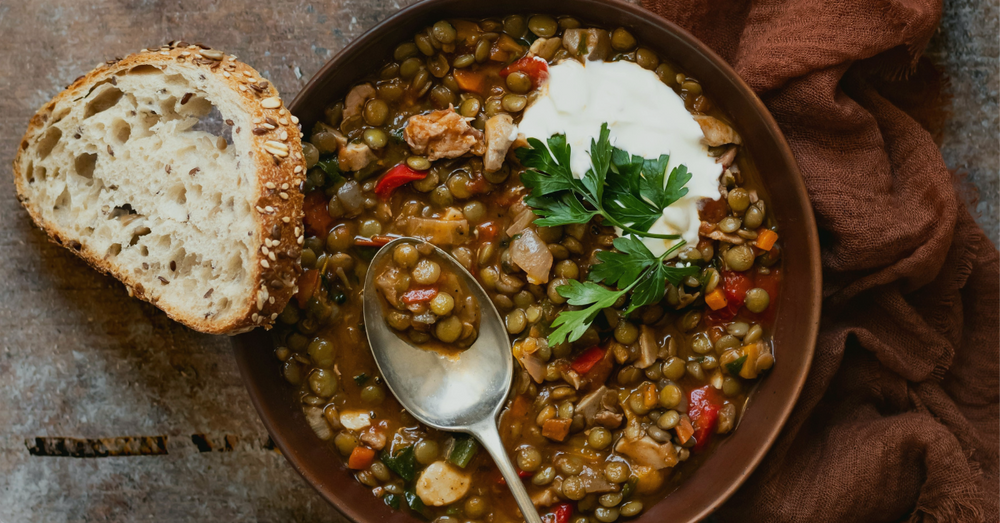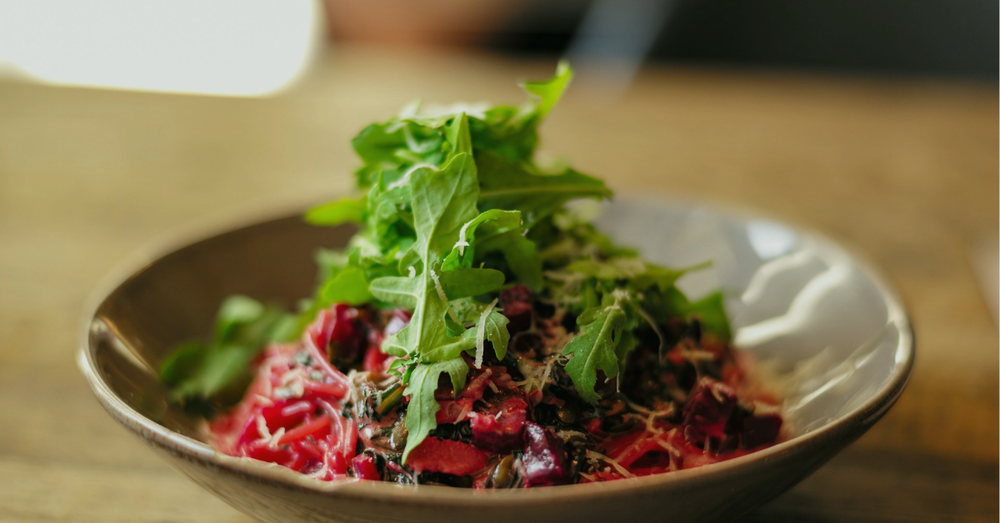This creamy green soup brings together broccoli, cauliflower, and kale for a delicious bowl that feels both comforting and energising. Finished with crispy chickpeas and toasted almonds, it is an easy way to enjoy a whole day’s worth of greens in one simple, nourishing meal.
9 benefits you should know about fibre.
9 Reasons You Need More Fibre in Your Diet We’ve all heard the advice: eat more fibre. But what does that really mean, and why is it so important? Fibre isn’t just about avoiding constipation (although that’s a big plus) but is involved in many other processes that play a role in our wellbeing. Let’s walk through why fibre deserves a starring role on your plate. What is Fibre? Fibre is a type of carbohydrate that our bodies can’t fully digest. Instead of being broken down into sugar, fibre travels through the digestive system largely intact, feeding the trillions of microbes that live in our gut. There are two main types of fibre: Soluble fibre: dissolves in water and forms a gel-like substance in the gut. It slows digestion, helps maintain blood sugar levels, and contributes to normal cholesterol levels. Examples: oats, apples, citrus fruits, beans, lentils, and barley. Insoluble fibre: does not dissolve in water and adds bulk to stool, supporting regular bowel movements. Examples: wholegrains, nuts, seeds, green beans, and the skins of fruits and vegetables.Most plant foods contain a mixture of both types, which is why variety is key. The Science of Why Fibre Matters When we look closely at what happens inside the gut, we see that fibre plays a central role in health through its impact on our gut microbiome. Different fibres nourish different bacteria which means that the more variety you eat, the more diverse and resilient your gut becomes. When microbes ferment fibre, they release short-chain fatty acids (SCFAs) such as acetate, propionate, and butyrate. Of these, acetate is usually produced in the greatest amount, followed by propionate and butyrate. Each of these has its own distinct role: Butyrate – the preferred fuel source for the cells lining the colon. It supports gut barrier strength,...

9 Reasons You Need More Fibre in Your Diet
We’ve all heard the advice: eat more fibre. But what does that really mean, and why is it so important? Fibre isn’t just about avoiding constipation (although that’s a big plus) but is involved in many other processes that play a role in our wellbeing.
Let’s walk through why fibre deserves a starring role on your plate.
What is Fibre?
Fibre is a type of carbohydrate that our bodies can’t fully digest. Instead of being broken down into sugar, fibre travels through the digestive system largely intact, feeding the trillions of microbes that live in our gut.
There are two main types of fibre:
-
Soluble fibre: dissolves in water and forms a gel-like substance in the gut. It slows digestion, helps maintain blood sugar levels, and contributes to normal cholesterol levels.
Examples: oats, apples, citrus fruits, beans, lentils, and barley.
-
Insoluble fibre: does not dissolve in water and adds bulk to stool, supporting regular bowel movements.
Examples: wholegrains, nuts, seeds, green beans, and the skins of fruits and vegetables.
Most plant foods contain a mixture of both types, which is why variety is key.
The Science of Why Fibre Matters
When we look closely at what happens inside the gut, we see that fibre plays a central role in health through its impact on our gut microbiome. Different fibres nourish different bacteria which means that the more variety you eat, the more diverse and resilient your gut becomes.
When microbes ferment fibre, they release short-chain fatty acids (SCFAs) such as acetate, propionate, and butyrate. Of these, acetate is usually produced in the greatest amount, followed by propionate and butyrate.
Each of these has its own distinct role:
-
Butyrate – the preferred fuel source for the cells lining the colon. It supports gut barrier strength, helps regulate local inflammation, and promotes mucus production. Some studies also show it may have antibacterial properties, by disrupting the way harmful bacteria use nutrients.
-
Propionate – travels from the gut to the liver, where it may help reduce cholesterol production and support lipid balance. Research also suggests it could play a role in limiting the processes that contribute to colorectal cell overgrowth.
-
Acetate – the most abundant SCFA, and an important player in energy regulation. It influences the release of appetite-regulating hormones like GLP-1 and PYY, which help balance blood sugar and support satiety (the feeling of fullness).
Together, these SCFAs help to fuel the gut lining, regulate metabolism, and maintain immune balance. They also act as messengers, travelling beyond the gut to influence systems across the body such as the brain.
In studies with mice, researchers observed that when fibre intake was low, gut microbes ran out of their preferred fuel and began consuming the gut’s protective mucus layer instead which made the gut wall more vulnerable. Scientists believe it is highly likely that a similar process takes place in humans.
9 Benefits of Eating More Fibre
-
Supports Regularity
Fibre contributes to normal bowel function by increasing stool bulk. -
Helps You Feel Fuller
High-fibre foods promote satiety (the feeling of fullness), which can help with appetite control. -
Helps Maintain Blood Sugar Levels
Fibre slows the absorption of glucose, supporting steady energy release. -
Nourishes Your Gut Microbiome
Fibre feeds beneficial bacteria, encouraging a more balanced and diverse gut community. -
Supports Immune Balance
By influencing gut bacteria and SCFA production, fibre helps maintain normal immune function. -
Contributes to Cholesterol Management
Certain soluble fibres, such as beta-glucans from oats and barley, help maintain healthy blood cholesterol levels. -
Supports Digestive Comfort
Adequate fibre intake can reduce occasional digestive discomfort, such as constipation. -
Maintains Colonic Health
Fibre helps to keep the gut environment healthy, supporting normal colonic function. -
Contributes to Long-Term Wellbeing
A diet rich in fibre is linked with balanced energy, better dietary quality, and improved long-term health outcomes.
Why a Synbiotic Can Help
You’ve probably heard of probiotics (beneficial bacteria) and prebiotics (fibres that feed them) but a synbiotic combines the two so they can work together to support gut health.
Here’s why that matters:
-
Nutrient absorption: A healthy gut environment helps ensure vitamins and minerals from your food are absorbed effectively.
-
Immune support: A balanced microbiome plays an important role in maintaining normal immune function.
-
Metabolic balance: Through compounds like SCFAs, gut bacteria influence processes linked to digestion and metabolism.
Conclusion
Fibre is best added through a variety of whole plant foods like fruits, vegetables, pulses, nuts, seeds, and whole grains to combine soluble and insoluble fibres. These fibres not only support digestion but also fuel the gut microbiome, leading to the production of SCFAs that help maintain the gut barrier, regulate metabolism, and balance immune responses.
Even modest increases in daily fibre can make a measurable difference. Adding one or two extra portions of fibre-rich foods each day is enough to begin shifting your gut environment in a positive direction, with benefits that extend well beyond digestion.
References
Facchin, S., Bertin, L., Bonazzi, E., Lorenzon, G., De Barba, C., Barberio, B., Zingone, F., Maniero, D., Scarpa, M., Ruffolo, C., Angriman, I., & Savarino, E. V. (2024). Short-chain fatty acids and human health: From metabolic pathways to current therapeutic implications. Life, 14(5), 559. https://doi.org/10.3390/life14050559
Holmberg, S. M., Feeney, R. H., Prasoodanan, V. P. K., Puértolas-Balint, F., Singh, D. K., Wongkuna, S., Zandbergen, L., Hauner, H., Brandl, B., Nieminen, A. I., Skurk, T., & Schroeder, B. O. (2024). The gut commensal Blautia maintains colonic mucus function under low-fiber consumption through secretion of short-chain fatty acids. Nature Communications, 15, 3502. https://doi.org/10.1038/s41467-024-3502-y
Vinelli, V., Biscotti, P., Martini, D., Del Bo’, C., Marino, M., Meroño, T., Nikoloudaki, O., Calabrese, F. M., Turroni, S., Taverniti, V., Unión Caballero, A., Andrés-Lacueva, C., Porrini, M., Gobbetti, M., De Angelis, M., Brigidi, P., Pinart, M., Nimptsch, K., Guglielmetti, S., & Riso, P. (2022). Effects of dietary fibers on short-chain fatty acids and gut microbiota composition in healthy adults: A systematic review. Nutrients, 14(13), 2559. https://doi.org/10.3390/nu14132559
lifestyle. gut health recipes.
ready in 10 minutes
herb-whipped cottage cheese chicken bagels.
These basil whipped cottage cheese protein bagels make a fresh, high-protein breakfast or lunch, combining creamy herb-blended cottage cheese with juicy chicken, rocket, and tomatoes. They’re quick to assemble, packed with flavour, and perfect for a nourishing breakfast or light lunch.
ready in 10 minutes
kiwi chocolate protein chia pots.
These Kiwi Chocolate Protein Chia Pots make an ideal high-fibre, high-protein breakfast that keeps you full and energised all morning. They’re quick to prepare, easy to store, and perfect for a healthy grab-and-go option.
ready in 15 minutes
spiced apple porridge.
This spiced apple and pumpkin seed porridge is a warming, high-fibre breakfast that’s perfect for cosy mornings. Made with creamy oats, gently caramelised apples and a crunchy pumpkin seed topping, it’s ready in just 15 minutes and serves one.
ready in 50 minutes
prep-ahead baked blueberry oats.
These prep-ahead oven-baked oats with blueberries and bananas are rich in protein and fibre, making them a nourishing, gut-friendly breakfast to enjoy all week.
ready in 15 minutes
spicy green eggs with feta.
These spicy green eggs with feta are a quick, protein-rich recipe packed with gut-friendly ingredients like spinach, courgette, and spring onion. Baked in the oven or air fryer, they’re simple to make, full of flavour, and support digestion with a balance of fibre, protein, and healthy fats. Perfect for breakfast, brunch, or a light meal, this vibrant dish proves that nourishing your gut can be both delicious and easy.
ready in 10 minutes
egg wrap with pesto.
Bright, fresh, and ready in just 10 minutes, this flavour-packed wrap serves one and is ideal for breakfast, lunch, or any time you’re after something simple yet filling.
ready in 10 minutes
peach cobbler overnight oats.
Start your day with a gut-friendly twist on a classic dessert. The peach cobbler overnight oats serve 2–3 and takes just 10 minutes to prepare the night before. Packed with fibre, flavour and feel-good ingredients, it’s the perfect make-ahead option for busy mornings or a nourishing snack you can enjoy any time of day.
ready in 15 minutes
smoky egg salad bagel crunch.
This smoky harissa egg bagel is the perfect 15-minute meal. Made with creamy Greek yoghurt, tangy pickles, and a hint of spice, it’s a high-protein twist on classic egg salad that delivers on both taste and texture. Ideal for busy days, this easy bagel recipe makes lunch feel gourmet without the effort.
ready in 20 minutes
chewy breakfast matcha protein cookies.
Soft, satisfying, and subtly sweet—these breakfast cookies are made to fuel your morning the right way. With fibre-rich oats, plant-based protein, and antioxidant-packed matcha, they’re a gut-friendly grab-and-go option that doesn’t compromise on flavour or function.
ready in 15 minutes
lemon & poppy seed pancakes.
Emily's light, gut-friendly crêpes are the perfect balance of fibre, protein, and healthy fats to support digestion and keep you feeling great.
ready in 10 minutes
carrot cake breakfast oats.
Start your day with a delicious and nutritious breakfast option - Carrot Cake Oats. Filled with fibre diversity to promote healthy digestion.










































